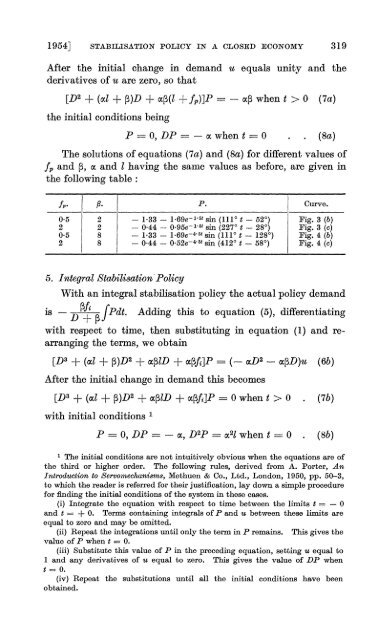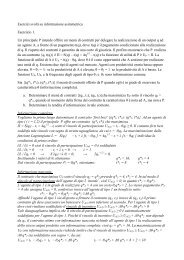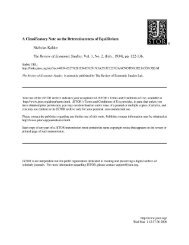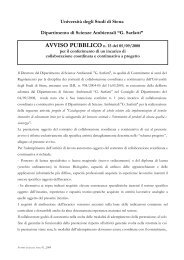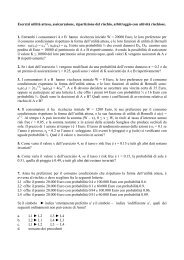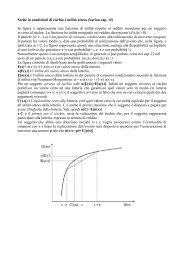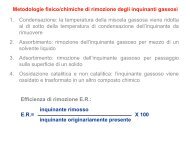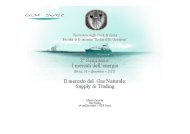Stabilisation Policy in a Closed Economy Author(s): A. W. Phillips ...
Stabilisation Policy in a Closed Economy Author(s): A. W. Phillips ...
Stabilisation Policy in a Closed Economy Author(s): A. W. Phillips ...
Create successful ePaper yourself
Turn your PDF publications into a flip-book with our unique Google optimized e-Paper software.
1954] STABILISATION POLICY IN A CLOSED ECONOMY 319<br />
After the <strong>in</strong>itial change <strong>in</strong> demand u equals unity and the<br />
derivatives of u are zero, so that<br />
[D2 + (Lxl + t)D + oc(l + fp)]P oc= when t > 0 (7a)<br />
the <strong>in</strong>itial conditions be<strong>in</strong>g<br />
P _ O, DP -oc when t = O (8a)<br />
The solutions of equations (7a) and (8a) for different values of<br />
fp and ,B, a and I hav<strong>in</strong>g the same values as before, are given <strong>in</strong><br />
the follow<strong>in</strong>g table:<br />
f. /3. P. Curve.<br />
065 2 - 1-33- 169e-1 5t s<strong>in</strong> (1110 t - 52?) Fig. 3 (b)<br />
2 2 - 044 - 95e- "I" s<strong>in</strong> (2270 t - 280) Fig. 3 (c)<br />
0.5 8 - 1*33- 169e-4 5t s<strong>in</strong> (1110 t - 1280) Fig. 4 (b)<br />
2 8 - 044 -052e-4 5t s<strong>in</strong> (4120 t - 58?) Fig. 4 (c)<br />
5. Integral Stabili,sation'<strong>Policy</strong><br />
With an <strong>in</strong>tegral stabilisation policy the actual policy demand<br />
is - D f fPdt. Add<strong>in</strong>g this to equation (5), differentiat<strong>in</strong>g<br />
with respect to time, then substitut<strong>in</strong>g <strong>in</strong> equation (1) and re-<br />
arrang<strong>in</strong>g the terms, we obta<strong>in</strong><br />
[D3 + (oal + 3)D2 + aclD + cP3fj]P (-acD2 - acD)u (6b)<br />
After the <strong>in</strong>itial change <strong>in</strong> demand this becomes<br />
[D3 + (cl + P)D2 + oc4ID + c43fi]P = O when t > 0 . (7b)<br />
with <strong>in</strong>itial conditions 1<br />
P 0, DP= - oc, D2P cx21 = when t == O . (8b)<br />
1 The <strong>in</strong>itial conditions are not <strong>in</strong>tuitively obvious when the equations are of<br />
the third or higher order. The follow<strong>in</strong>g rules, derived from A. Porter, An<br />
Introduction to Servomechanisms, Methuen & Co., Ltd., London, 1950, pp. 50-3,<br />
to which the reader is referred for their justification, lay down a simple procedure<br />
for f<strong>in</strong>d<strong>in</strong>g the <strong>in</strong>itial conditions of the system <strong>in</strong> these cases.<br />
(i) Integrate the equation with respect to time between the limits t= -0<br />
and t = + 0. Terms conta<strong>in</strong><strong>in</strong>g <strong>in</strong>tegrals of P and u between these limits are<br />
equal to zero and may be omitted.<br />
(ii) Repeat the <strong>in</strong>tegrations until only the term <strong>in</strong> P rema<strong>in</strong>s. This gives the<br />
value of P when t = 0.<br />
(iii) Substitute this value of P <strong>in</strong> the preced<strong>in</strong>g equation, sett<strong>in</strong>g u equal to<br />
1 and any derivatives of u equal to zero. This gives the value of DP when<br />
t = 0.<br />
(iv) Repeat the substitutions until all the <strong>in</strong>itial conditions have been<br />
obta<strong>in</strong>ed.


